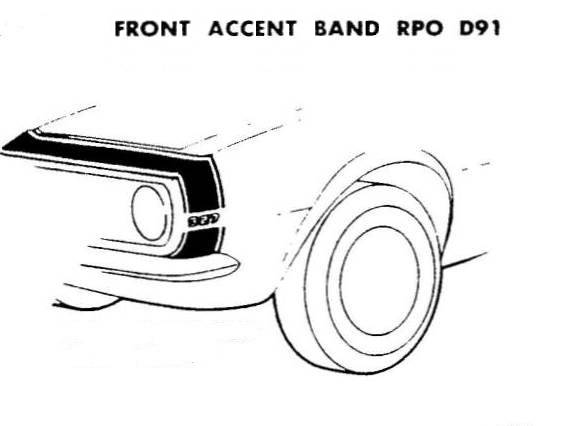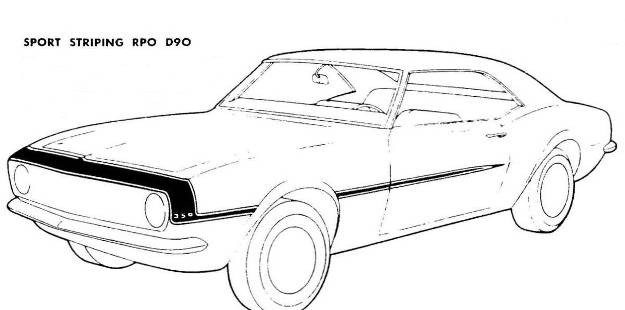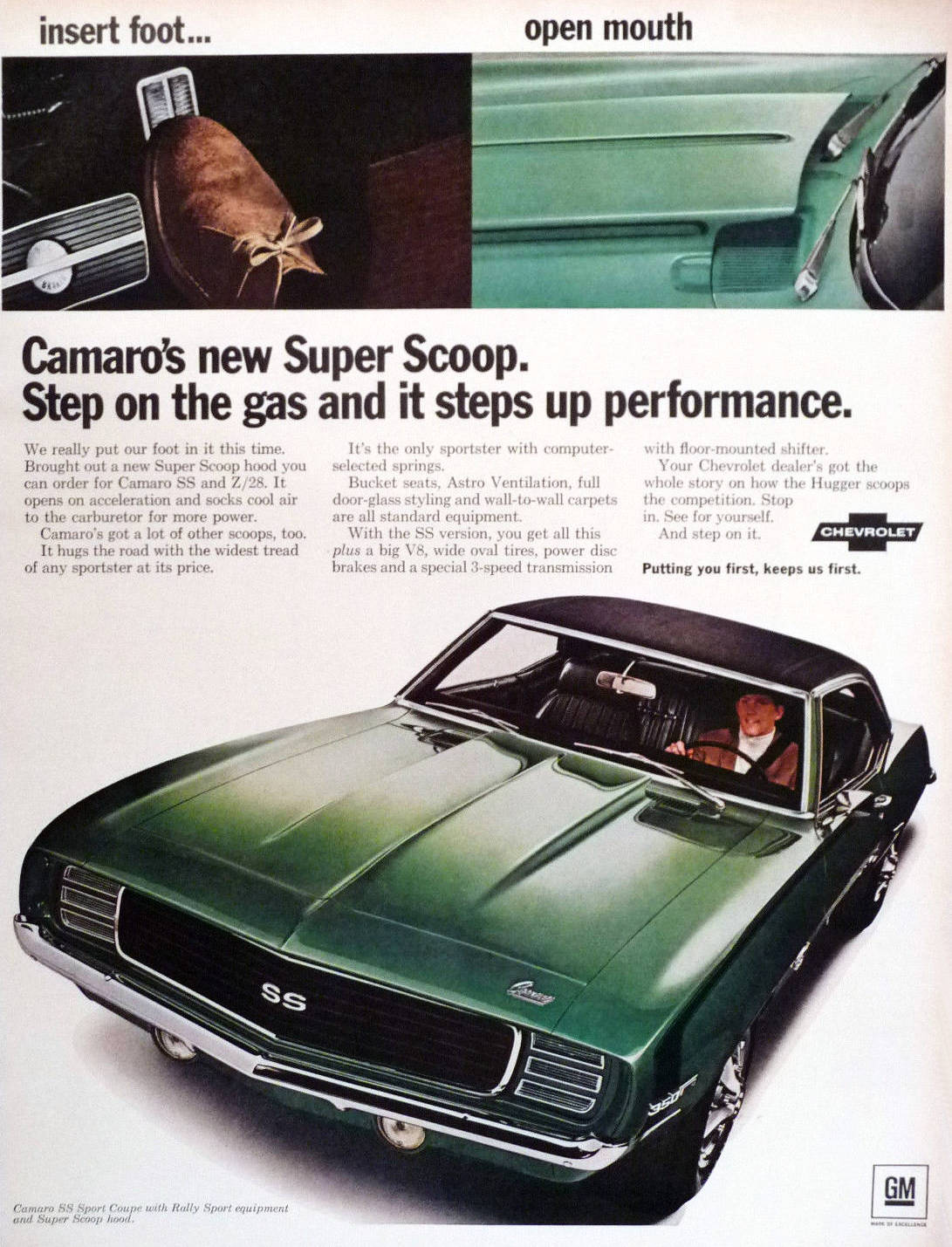| D91 Stripe - 67 SS and early 68 SS | D90 Stripe - late 68 SS | |

|

|
| C R G | CRG Reports | Exterior | Engine | 1967 Model ID |
| Numbers Decode | General Info | Interior | Transmission | 1968 Model ID |
| Drivetrain Decode | Options | Underhood | Chassis | 1969 Model ID |
©1998-2025, Camaro Research Group
Edited by Rich Fields and Kurt Sonen
Version: Tuesday, 18-Nov-2025 00:33:32 EST
Note: for a list of Exterior colors by year and other exterior color details, including special paint designation, RPO and window sticker codes, and related stripe and top colors, see the Exterior Colors section of the Numbers/Decoding page.
Note that the 1969 percentages are only until September 69 and do not included the extended 69 production year (about 13% of 69 production). That should not affect the 1969 percentages significantly. We will also note that these production numbers are close to the estimates that we had published previously using the CRG database. Here is more information on exterior colors.
1967 1968 1969
--------------------- --------------------- -----------------------
Use Use Use
Color Code (%) Color Code (%) Color Code (%)
------------------- ---- ------------------- ---- ------------------- ---
Tuxedo Black A 2.2 Tuxedo Black A 0.9 Tuxedo Black 10 0.6%
Ermine White C 10.8 Ermine White C 7.2 Butternut Yellow 40 1.7
Nantucket Blue D 5.2 Grotto Blue D 6.2 Dover White 50 7.9
Deepwater Blue E 3.1 Fathom Blue E 1.3 Dusk Blue 51 3.3
Marina Blue F 12.2 Island Teal F 3.0 Garnet Red 52 7.7
Granada Gold G 13.1 Ash Gold G 12.4 Glacier Blue 53 4.7
Mountain Green H 3.6 Grecian Green H 2.6 Azure Turquoise 55 2.7
--- Rallye Green J 4.6 Fathom Green 57 9.4
Emerald Turquoise K 4.2 Tripoli Turquoise K 4.6 Frost Green 59 11.4
Tahoe Turquoise L 3.5 Teal Blue L 3.1 Burnished Brown 61 2.3
Royal Plum M 2.7 --- Champagne 63 0.6
Madeira Maroon N 4.6 Cordovan Maroon N 3.4 Olympic Gold 65 6.2
--- Corvette Bronze O 5.7 Burgundy 67 2.3
--- Seafrost Green P 3.3 Cortez Silver 69 6.2
Bolero Red R 13.8 Matador Red R 11.0 LeMans Blue 71 12.4
Sierra Fawn S 2.0 --- Hugger Orange 72 8.5
Capri Cream T 4.7 Palomino Ivory T 1.6 Daytona Yellow 76 6.7
--- LeMans Blue U 9.4 Rallye Green 79 4.9
--- Sequoia Green V 3.0
Butternut Yellow Y 13.5 Butternut Yellow Y 9.4
British Green Z 6.0 Two-Tone Paint 1.8
Special Paint O 0.7 Special Paint - 1.4 Special Paint - 0.6
|
In 1967, these were Tuxedo Black, Ermine White, and Marina Blue.
In 1968, two colors, Tuxedo Black and Cordovan Maroon, started the year common to both Camaro and Corvette. In January 1968, three additional Corvette colors were added to Camaro, with specific marketing attention given to the fact that they were Corvette colors applied to Camaro. These three were Corvette Bronze, LeMans Blue, and British Green. (In addition to these three, Rallye Green was another mid-season Camaro color addition. Together they replaced Fathom Blue, Grecian Green, Palomino Ivory, and Tuxedo Black for the remainder of 1968.) As a result, Corvette shared a total of five colors with Camaro in 1968.
In 1969, there were seven colors shared: Tuxedo Black, Fathom Green, Burgundy, Cortez Silver, LeMans Blue, Hugger Orange (known on the Corvette as Monaco Orange), and Daytona Yellow.
For Pontiac, the color went by different name, Carousel Red. For Corvette, it was called Monaco Orange.
Picture of RS cars are shown on the Model page.
Starting in January of 1968, the 1968 SS cars received the new D90 sport stripe. This stripe went across the header panel, similar to the D91 stripe, but it also extended back across the fender and onto the door.
For the 1969 SS models, the D90 stripe was modified from the 1968 version to what is known as the "hockey stick" stripe. For 1969, the D90 stripe was not on the header panel - it was only located on the fender and door. With both the 68 and 69 D90 stripes, the front part of the stripe is painted on, while the part from the back edge of the fender and across the door (or just the door in 69) is a decal.
The D90 stripe (aka sport striping, shown above), used on the January and later 68 SS cars, became available in January of 1968 as an option on all 1968 non-Z28 models.
The D96 side striping was added for the 1968 model year. This consisted of a stripe that ran along the belt line of the car from the fender across the door and onto the quarter panel. The D91 and D96 stripe packages could be ordered together and early 68 SS cars with the D91 stripe could also have the D96 stripe. The D96 stripe was not available with the D90 stripe (since they would have been on top of eash other).
DX1 was a new stripe option which was only available on non-SS, non-Z28 Camaros. The DX1 striping package had a stripe on the header panel and fenders (similar to the D91 stripe) that extended down the center of the hood.
The D96 stripe was modified for 1969. It consisted of two pinstripes - each stripe started along the front edge of the wheel opening and extended rearward over the wheel opening, following the body line. The D96 stripe was included with style trim or rally sport and was also available as a stand-alone option. Though GM documentation states that the D96 stripes were "Not available when Camaro SS, Special Performance Package, or Sport Striping is ordered", the D96 stripes have been observed on some original Z28's and SS cars.
For the 1968 model year, the chromed hood trim for SS396 changed from the simulated finned cooler to a set of simulated carburetor velocity stacks. The early 1968 model year SS350 continued to receive the 1967-style finned hood trim through October. Beginning in November 1967, the SS350 transitioned to the velocity stack trim (same as the SS396). The simulated velocity stack continued for the 1969 model year with all SS cars using this same hood trim. Related to this, the part number for the 1968-69 hood is different than 1967, with the major difference being the drains used with the velocity stack trim.

|
Despite early press photos showing the hood, it was not available at the start of production. Option information was released to dealers via a letter from Chevrolet dated November 25, 1968. Chevrolet released two print ads for the option, featuring Hugger Orange and Rallye Green Camaro SS coupes. The ads referred to it as the “Super Scoop” hood; availability was limited to Camaro SS and Z28 models. It was also mentioned in later print ads for the Indy Pace Car replica. It was referred to as Special Ducted Hood on the ordering information. Chevrolet never referred to it as “Cowl Induction”; that term was introduced for a similar optional hood for the 1970 Chevelle SS.
At this time, the earliest known documented production ZL2 installations are a 12C Z/28 at Van Nuys and Norwood ZL1 #1 9N569358, built late December 1968. Both cars exist today with their Body Broadcast Copies. Neither has any special notes on the sheet as might be expected, as the system required piercing holes in the body structure plus different and additional component parts. It is possible neither car was the first. The hood was initially in short supply as an option. It may have been allocated to the Indy Pace Car replicas, Z10's, and COPO production. Pace Car and Z10 production ended early in May 1969, freeing up availability. At the end of production, slightly over 40% of the 10,026 optional ZL2 installations were Z10's and Z11's. The majority of 1969 Camaro SS and Z28 did not have the hood.
Chevrolet also offered a version of this hood for roadracing. It was available only as an over the counter retrofit, designed to be used with the 2 x 4 barrel cross-ram carburetion system. The cross-ram hood was available in both fiberglass and steel (the rules of the racing series would dictate which one was legal to use). Chevrolet fitted the now-famous 68 Camaro Z28 convertible with the hood and carburetion system for display at Trans-Am events late in 1968. Although the first public viewing of the hood was on a 1968 Camaro, ironically it was never a 1968 option. The entire induction system has been available in reproduction for decades making early retrofits possible.
Around the February to early March 1967 timeframe, a new underside support structure was implemented to replace the original design. This new stamping added indentations and holes which were needed for the spoiler for the 68 Camaro (the Firebird may also have had some influence on the design). While no 67 Camaro was built with a factory installed rear spoiler, the new underside facilitated spoiler installation when Chevrolet made the rear spoiler available in 1968.
The trunk lid was changed again for 68, namely for the new emblem design and an additional hole for the emblem when equipped with a spoiler. This design was used during the 68 model year and into the 69 model year. The trunk lid was changed again in the December 68 time frame to add holes to enable installation of the Firebird Trans-Am spoiler.
The final version for 69 incorporated minor changes, namely removal of the tabs on the rear edge of the trunk lid and a change in the date code location. Service trunk lids have an extra hole in center of the support panel. That hole only appeared on some early 67 decklids (which will have the early style underside) and service parts (which have the spoiler holes, etc.) - no other production Camaro trunk lids have that hole.
Body sill black-out paint was applied to Z22 (RS) cars in 1967 and 1968 and to Z21 (style trim) and Z22 (RS) in 1969. But there were several body colors that were simply just too dark for this paint scheme to be effective and for these colors, the body sill black-out paint was omitted. Additionally, the body sill black-out was omitted for the 1969 Z11 Indy Pace Car convertible trim package and the 1969 Z10 coupe trim package. A Chevrolet Product Bulletin dated 2-4-69 describes the Z11 (Pace Car trim package) package and includes this instruction: "Body sill to be painted white instead of black." Although no instructions have been found for the Z10 coupe, the intent would have been the same.
There was also a paint color exception for the SS-396 tailpan black-out, but it was limited to black vehicles and the Z11 and Z10. Black SS-396 cars would not have received the (semi-gloss) blacked-out tailpans. But it should be noted that a few original paint black SS-396's have been observed with blacked-out tailpanels - the paint difference is only visible at the paint tape line.
1967 1968 1969
---- ---- ----
AA Tuxedo Black AA Tuxedo Black 10 Tuxedo Black*
EE Deepwater (Dark) Blue EE Fathom (Dark) Blue 51 Dusk (Dark) Blue
LL Tahoe Turquoise NN Cordovan Maroon 57 Fathom (Dark) Green
MM Royal Plum VV Sequoia Green 61 Burnished Brown
NN Madeira Maroon NN Cordovan Maroon 67 Burgundy
--------
* We have not found GM documentation for the 1969 Tuxedo Black body
sill exception. However we believe it followed the pattern of previous
years and original 1969 cars bear this out.
|
|
|
|
|
Figures 1a and 1b show the center of the front bumper. The 1967 bumper, part number 3886690, has one hole for mounting the front license plate holder to the bumper. The 1968 bumper, part number 3929954, has 2 additional holes for mounting a bracket (#21) and rubber bumper (#22).
Figures 2a and 2b show the end of the front bumper for each year. The bumper mounting brackets are different for the two years. The 1967 bracket extends down to the lower part of the bumper, attaching with a bolt (#12) to a mounting hole in that location. The 1968 bracket is attached to the bumper only with the top-side bolt (#20) at the end and the bottom hole in the bumper was removed. The #20 bolt system was redesigned from 1967 and changed to use rubber cushions.
While they are similar, due to mounting hole differences, a 1967 Camaro front bumper can be mounted on a 1968 model only if the '68 center mounting pad is not installed. Likewise, a 1968 Camaro front bumper can be mounted on a 1967 model only if the '67 lower end brackets are left unattached.
|
|